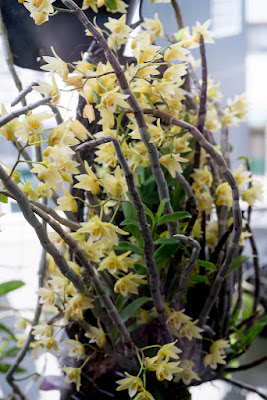Dendrobium dixanthum is found in Myanmar, Thailand and Laos. It grows in the tops of tall trees in deciduous forests at altitudes of 200 to 960 meters above sea level.
Dendrobium dixanthum also called as The Twice Yellow Dendrobium, Callista dixantha, is a species of the genus Dendrobium. This species was described by Heinrich Gustav Reichenbach in 1865.
IDENTIFY DENDROBIUM DIXANTHUM ORCHID PLANT
Dendrobium dixanthum is found in Myanmar, Thailand and Laos. It grows in the tops of tall trees in deciduous forests at altitudes of 200 to 960 meters above sea level.
It is a medium to large sized, hot to warm growing epiphytic species with erect to pendant, terete, 30-40 cm long stems carrying 4, ligulate to lanceolate, suberect, acute or acuminate leaves that fall from the stems before the flowers appear.
The Twice Yellow Dendrobium blooms in the winter and spring on pendant racemes emerging from the nodes at and near the apex of mature pseudobulbs carrying thin textured flowers. The sepals are narrow and pointed, while the petals are oblong and rounded. Both are a light yellow in colour. The lip is broad and squarish, the margins being edged with a series of tiny serrations. It is about the same colour as the segments, with a deeper yellow patch in the middle.
DENDROBIUM DIXANTHUM ORCHID PLANT CARE AND CULTURE
Cultural information should only be used as a guide, and should be to be adapted to suit you. Your physical location; where you grow your plants, how much time you have to devote to their care, and many other factors, will need to be taken into account. Only then can you decide on the cultural methods that best suit you and your plants.
Light:
Dendrobium dixanthum like plenty of light, but cannot stand the full noonday rays of the sun (15000-40000 lux, filtered or diffused light is recommended.). These usually do best when placed so that they can get the early morning sun, but are shaded from about 10 a.m. onwards in the Summer time. In the Winter they can usually stand the sun's rays up to 11.30 a.m.
Temperature:
The average temperature of the summer day is 30-32 ° C, night 22 ° C, giving a daily difference of 8-9 ° C. In winter the average day temperature is 28-31 ° C, night 11-13 ° C, giving a daily difference of 15-18 ° C.
Humidity:
From summer to autumn, The Twice Yellow Dendrobium need the humidity of 80-85%, but for most of the remaining period it drops to 60-70%.
Too dry air has a negative effect on the development of the plant: its growth is inhibited, and the leaves begin to turn yellow and dry out. The higher temperature, the higher the humidity should be, and the higher the humidity, the more often and longer it is necessary to ventilate the room where the plants are contained, otherwise the probability of rotting and various kinds of fungal diseases.
Substrate, growing media and repotting:
Dendrobium dixanthum grows best in pots with staghorn peat as substrate (crocks and charcoal at the bottom of the pot). After potting, keep the plant in a cool, shady place for a few days before placing it in its growing position. Do not overpot. Use the smallest pot that will accommodate your plant.
It does not need frequent repot, therefore, it is desirable to transplant only when it is really necessary, for example, in cases of strong salinization or compaction of the substrate, at its critically high or low pH (the norm is from 5.5 to 6.5) or when the plant grows very strongly and the pot becomes cramped to it (pseudobulbs begin to hang from the edges of the pot). Repotting is best done immediately after flowering when new roots and new growth begin to grow.
Watering:
The Twice Yellow Dendrobium will require heavy watering until well into the Autumn, the plants then being allowed to dry out for the Winter, except for a soaking about once in four to six weeks.
Watering is directly dependent on the temperature of the content, the higher it is, the more often it needs to be watered. When watering, excess water should flow freely from the pot, since stagnation of water both inside the pot and in its pan can very quickly lead to rotting of the roots and the lower part of the plant.
Fertilizer:
It is recommended to use a 1/4-1/2 dose of orchid fertilizer weekly. You can use the balanced fertilizer throughout the year or from spring to mid-summer use high-nitrogen fertilizer, and then until the end of autumn high-phosphoric fertilizer to stimulate flowering.
Rest period:
Dendrobium dixanthum need less water in the winter, especially if they grow under the conditions of a dark, short day that occurs at moderate latitudes. They should dry somewhat between waterings, but they should not be dry for a longer period. Frequent morning fogging and rare, economical watering should allow the plant to go through a dry period of rest, while providing it with sufficient humidity. Fertilization should be reduced or eliminated until new growths appear and a more abundant spring watering begins.















COMMENTS